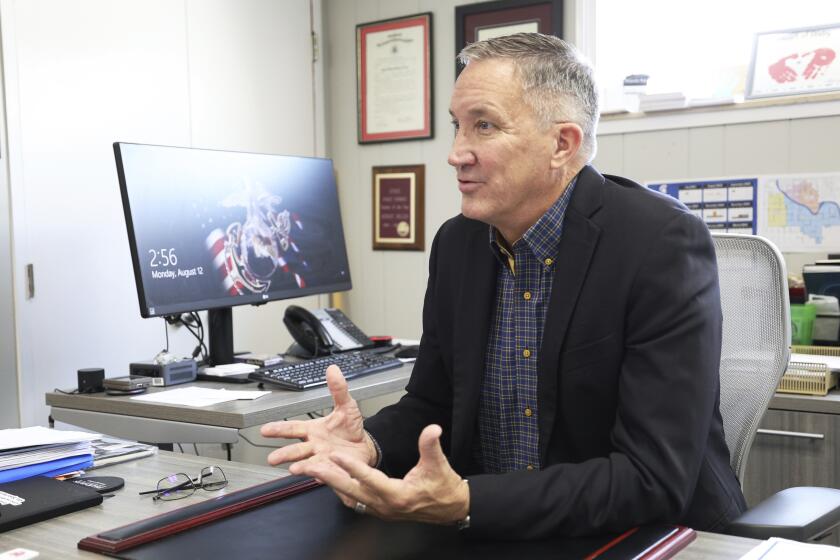Ramon Cortines
Ramon C. Cortines, 67, who frequently says he was a mischievous kid growing up in San Francisco, has held some of the most challenging jobs in public education in the course of a 43-year career. Now, he’s being talked about for another one: the interim successor to Ruben Zacarias, the veteran L.A. educator whose contract the L.A. school board now wants to buy out.
Cortines is blunt-spoken, passionate about the unrecognized talents of poor and minority children and impatient with the slow speed at which most bureaucracies move. Whe he was superintendent in San Francisco, he called district headquarters the “puzzle palace” and derided administrative “tea parties” and bureaucrats who “like to play school.”
He was involved in litigation involving school desegregation while serving as superintendent in Pasadena for 11 years; the issue resurfaced when he took over the top post in San Jose and was also part of the political landscape in San Francisco.
Cortines says he had the misfortune to have to cut budgets in all three districts. Yet, while he admits to having a temper, he nonetheless managed to build strong support on all the boards of education he has served.
In San Francisco, for example, the vote to hire him was split, but he soon won over the doubters, and most decisions were made unanimously. The same occurred in New York City, where he became chancellor in 1993. But though he enjoyed support from the board, he came under constant attack from New York Mayor Rudolph W. Giuliani. Cortines quit in 1995.
In retrospect, Cortines said he wasn’t “hungry enough” to keep fighting for his job in New York. “I didn’t go there to fight the mayor. And I felt I could not further my agenda without the mayor’s support.”
He is currently affiliated with Stanford University, where he is executive director of the Pew Network for Standards-Based Reform. Among his other affiliations is a position on the board of directors of the Edison Project, the largest private operator of public schools in the country.
During all his travels, Cortines has maintained a home in Pasadena, a pied-a-terre in San Francisco and a ranch outside Porterville, Calif. Dressed in a crisply starched, blue-stripe dress shirt, pressed blue jeans and loafers, Cortines sat down for a conversation early last week in the library of his Pasadena home, where books on music, art and education share shelf space with contemporary mysteries written by Walter Mosley, Ed McBain and Sue Grafton. Three days later, the L.A. Board of Education made plans to buy out Zacarias’ contract.
*
Question: What has gone wrong with Los Angeles’ schools?
Answer: I think the problem in a system like L.A. is that I’m not sure there is the will of the community to improve education.
We blame kids, we don’t set expectancies high enough, we don’t support and nurture teachers the way we should. We don’t reward and recognize outstanding principals. In L.A., everywhere you go, there are outstanding teachers and outstanding principals . . . and they’re treated the same as everybody else.
Q: How serious is the situation the schools are in?
A: Look at the Ford Motor Co. They made drastic changes at every level, including their product, and helping their employees understand that they were going to go out of business . . . because their competitors were going to beat them.
We in the public schools had better get the message. Because public schooling, as we know it, is going to go out of business--through privatization, through all sorts of charter schools, through vouchers.
Q: The members of the L.A. Board of Education who voted to appoint Howard Miller as CEO said their biggest concern was that the district was being mismanaged. What does good management look like in a big district like Los Angeles?
A: Somebody told me when I went to New York, “You can’t do anything there. It’s too big.” But it’s not that much different from my 6th-grade class of 44 kids, except for the scale.
I did 32 meetings the first year. I needed to listen to parents. In the two years I was there, I visited over 400 schools, generally unannounced, looking at instruction, to see if they were carrying out what they needed to do. To see what they needed, to see how I could support them, to look at the environment.
It’s not about toxic wastes. It’s not that we need more schools because of the growth in L.A. It’s not that the kids don’t have libraries or science labs or that there’s not a mentoring program or a community-service program. It’s about all of those. It’s about connecting all of those. And that’s what the management of the district needs to be held responsible for.
Q: One of the biggest issues of managing big-city school districts is managing the politics, with the school board or the mayor. How do you do that?
A: I’ve had some successes in that. But the reason I left New York with three more years on my contract was that I did not believe I could further the agenda without the mayor’s support.
Do you have to work with mayors? The answer is yes. Do you have to work with elected officials? The answer is yes. Do you have to work with unions? The answer is yes. But you are the No. 1 manager and educator in the district, and you have to provide leadership, and you have to expect leadership of those who work for you.
Q: One continuing problem in Los Angeles has been the poor performance of the district’s students in reading. What can we do?
A: When I was superintendent in San Francisco, I looked at the test scores and I saw that my primary children were reading, on an average, a year or a year and a half below grade level. I took my federal Title I money for disadvantaged students and . . . set up Saturday schools.
Now, you could not just send your kid. You had to come and register your kid. And you had to come once a month as a parent and participate. In one year, attendance increased, disruptive behavior decreased, parent involvement increased and the standardized-test scores increased slightly.
Well, those are all the important components of success, of making progress. It’s not as simple as saying, if you just do this reading program or that math program. It’s the consistent effort, over five to 10 years. Everybody says we can’t wait that long. Well, then, we’d better get started.
Q: People say education is different from a business and can’t be managed the same way. Do you agree?
A: That’s a cop-out. I was a caring educator. But I ran districts as a business. I said, “This is what I would be responsible for.” And when we didn’t measure up, I told them.
I remember when I was in New York was the only time in seven years they had improved in all 32 school districts in reading and math on standardized tests. Did I do it? No. But, damn it, I was the Elmer Gantry, and it was my job on the line.
In San Francisco . . . when I would go into the classroom and the first thing I would see was . . . they would pass out the sheets and the color crayons and they would start coloring. Not creative art. Coloring in the lines.
These were disadvantaged kids. Instruction has got to be looked at instead of “You know where those kids come from.” Or, “You know the ethnicity of those kids.” Or, “You know there’s only one parent.”
Those are all straw men. Are those issues to be dealt with? Hell, yes. But you’ve got to deal with them.
Don’t give me an aspirin when I’ve got cancer. Don’t just give me seat time and have me color in the lines.
Q: So you changed that.
A: Hell, yes. It can’t just be fun and games all the time. What we’re doing in America, in urban education, all too often, is that we’re playing school, rather than understanding that this is hard work for kids, hard work for teachers and hard work for the principal.
Q: In the past two weeks, there’s been a lot of talk about the ethnic politics of the district. What’s your view?
A: It’s not about ethnic politics. When I hear about ethnic politics in L.A., I become sick. This is a minority school system. To me, it’s not the flight of different groups that bothers me. It’s “bright flight” that bothers me--of all ethnicities.
Q: How do you reverse that and attract back bright kids?
A: In San Francisco, the last three years I was there, I had about 2,500 to 3,000 kids a year coming from the parochial and private schools. I looked at what the private and parochial schools were doing and what the parents wanted.
At Polytechnic in Pasadena and Westridge, every kid has to do a community-service project. Why isn’t foreign language offered in the middle schools in L.A.? That’s how I got kids back. I said algebra would be in every middle school. They told me, “Our people aren’t prepared.” I said, . . . “Get them prepared.”
In L.A., every high school should have advanced placement and honors courses. Don’t tell me about “those kids.” In San Francisco, when I put the algebra program in every middle school, I didn’t mandate it. But after the first year, I said, tell me how many students . . . passed it. And how many more young women. And how many more African American students and how many more Latino students.
See, it is the opportunities that you have to be thinking about. For L.A. to have a renaissance in education, it means people have got to stop saying, “Hey, we just need to give up on . . . public education.” It’s easy to say, “Hey, it’s so bad, I can’t do anything.” But you’ve got to start.
Q: Since 70% of the students in Los Angeles are Latino, should the next superintendent be Latino?
A: No. No. It should be the best possible educator-manager in America. Can you find a Latino? Yes. But this is not about ethnicity. This is about leadership and integrity that understands that the place has to be managed. Classrooms have to be managed. This is not rocket science.
Q: What does leadership look like in an urban district?
A: Leadership is out in front, it is on the cusp, it is taking risks. But leadership is also behind--pushing, cajoling, thumb in the back. And leadership is also locking arms, and walking side by side. There is no cookie-cutter approach to leadership.
Some of the best times I’ve been a leader, I think, is when I said, “I screwed up. I don’t know.” Honesty and integrity are a sign of leadership, and that’s not really rewarded.
Q: Why are you still so passionate about this stuff and so involved?
A: We need to look at education selfishly. You take 500,000 or 600,000 kids and they’re going to affect your economics and my economics. If we don’t see that they maximize their potential, then we will pay for it another way.
Q: Is there hope?
A: Oh, yes. Let me tell you a story.
The first week I arrived in New York, there were such asbestos problems, I had to delay the opening of schools. There were 400 people and my office was on the 10th floor and I heard them yelling and screaming and I went to the window and said, “What is that noise?” They said, “They’re protesting.” And I said, “I must go down and see.” And the security guys said, “Oh, no, you can’t.”
I said, “I beg your pardon. If those are parents of the school district, I have a responsibility.” I went down. And they yelled at me. I said, “What do you want me to do?” They said, “We want you to come and see the school.” I said, “I’ll be there at 2 p.m. this afternoon.”
I went to that school--this was in Bedford Stuyvesant. And there was this woman who said, “Aren’t you afraid to be here?” And I said, “Oh, should I be?” She said, “No, but no other chancellor’s ever been here.”
Let me tell you, the water fountains were broken. . . . The windows were broken, and the shades kept the wind and the rain out. The building was leaking. I was brand new, nine days. But I said, “The school is closed.”
People said, “Where are you going to move it?” I said, “I don’t know. But that is not a place where kids can learn and where I can hold teachers and principals accountable.”
We moved them . . . into other schools, but before Christmas they were in their own school. So, when we reopened the school, that same lady came up to me. She said, “Do you remember me?” I said, “No.” She said, “You’ve been back three times.”
You can give them hope. You have to follow through. It’s not just recommending. Part of leadership . . . is kicking butt to make sure it happens for boys and girls and young people.
More to Read
Sign up for Essential California
The most important California stories and recommendations in your inbox every morning.
You may occasionally receive promotional content from the Los Angeles Times.






